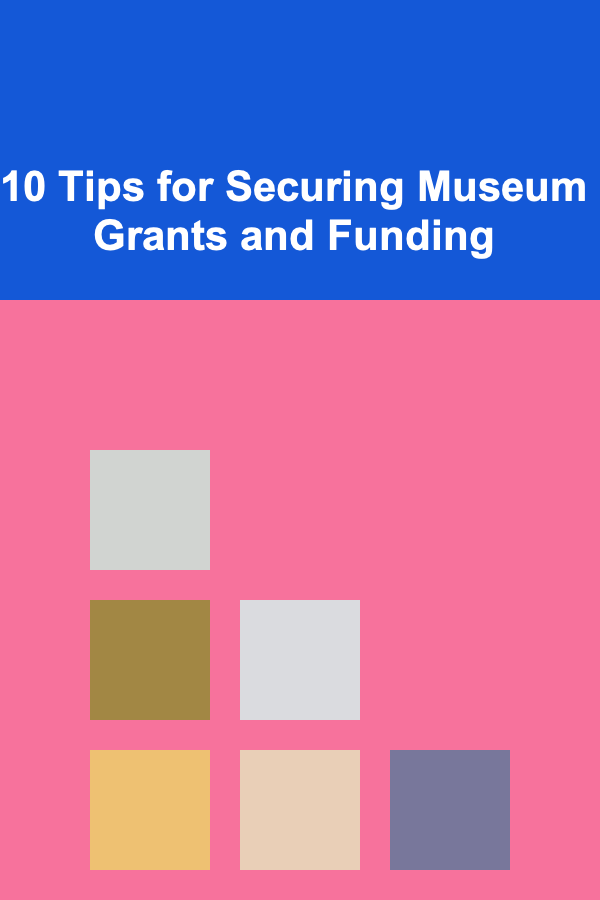
10 Tips for Securing Museum Grants and Funding
ebook include PDF & Audio bundle (Micro Guide)
$12.99$7.99
Limited Time Offer! Order within the next:

Securing funding for museums has always been a challenging yet essential aspect of maintaining their operations, exhibitions, educational programs, and preservation efforts. Museums play a vital role in preserving culture, educating the public, and offering unique experiences, but often their funding relies heavily on grants and external financial support. Whether you are managing a small community museum or a large, internationally renowned institution, understanding how to navigate the complex world of museum grants and funding can make a significant difference in ensuring the long-term sustainability of your organization.
In this article, we will explore 10 essential tips for securing museum grants and funding, focusing on everything from identifying the right funding sources to crafting compelling proposals and building relationships with funders.
Understand the Landscape of Museum Funding
Before diving into the process of securing grants, it is crucial to understand the diverse landscape of funding options available to museums. These can generally be divided into two categories: public and private funding.
Public Funding:
- Government grants: These are typically provided by federal, state, or local government agencies. In the U.S., agencies like the National Endowment for the Arts (NEA), the National Endowment for the Humanities (NEH), and the Institute of Museum and Library Services (IMLS) are prime sources of funding for museums. These agencies fund projects that align with their strategic priorities and support public access to the arts and culture.
- Municipal and regional support: Many local governments allocate funds for cultural institutions, including museums, to foster cultural tourism, educational initiatives, and community engagement.
Private Funding:
- Foundations and nonprofit organizations: Private foundations are an important source of funding for museums. Some well-known examples include the Getty Foundation, the Ford Foundation, and the Kresge Foundation. These foundations have specific missions that align with the work of museums, such as preserving cultural heritage, supporting arts education, or fostering community engagement.
- Corporate sponsorships and partnerships: Museums often receive funding through corporate sponsorships. In return, companies may gain exposure through museum exhibitions, educational programs, or events.
- Individual donors: Many museums rely on the generosity of individual donors, whether through annual giving, major gifts, or endowment funds.
Tip:
Conduct thorough research on the funding landscape in your region and field. This will help you identify potential sources of financial support and understand their specific priorities and application requirements.
Define Your Museum's Mission and Impact
One of the first steps in securing funding is clearly defining your museum's mission and the impact of its work. Funders want to support organizations that have a clear sense of purpose and demonstrate tangible, positive effects on the community.
Mission Statement:
Your mission statement should concisely convey what your museum stands for and what it aims to achieve. It should be aligned with the priorities of potential funders and reflect how your museum contributes to the broader cultural and educational landscape.
Impact:
Be prepared to articulate the specific impact your museum has had or plans to have in areas like:
- Education: How does your museum engage the public in learning about art, history, science, or culture?
- Preservation: What efforts are you making to preserve important artifacts, documents, or artworks for future generations?
- Community Engagement: How does your museum serve the local community or contribute to a more vibrant cultural scene?
Tip:
Clearly demonstrate how your museum's mission and impact align with the priorities of the grant-making organization. Whether it's promoting education, increasing access to the arts, or fostering cultural preservation, make sure your museum's goals resonate with funders.
Identify the Right Funding Sources
Not all grants are suitable for every museum, so it's essential to identify the right sources of funding for your institution. Some grants are designed to support specific types of projects, while others are more general. Research and identify funders whose priorities align with your museum's mission and projects.
Types of Grants to Consider:
- Project Grants: These are typically one-time funding opportunities for specific initiatives such as exhibitions, educational programs, or preservation efforts.
- General Operating Support: Some funders offer grants to help museums cover their general operating costs, including staff salaries, facility maintenance, and other day-to-day expenses.
- Endowment Grants: These grants are designed to support the long-term sustainability of the museum by contributing to its endowment fund, ensuring the institution's financial stability for years to come.
- Capital Campaign Grants: If your museum is undertaking a large capital project, such as expanding its building or renovating facilities, you may be able to apply for grants dedicated to such efforts.
Tip:
Look beyond just the major foundations and government programs. Smaller, local funders, and niche foundations may provide valuable support for specific aspects of your museum's operations, such as educational programming, diversity initiatives, or specific collections.
Develop a Strong Grant Proposal
Your grant proposal is your chance to make a compelling case for why your museum deserves funding. A well-written proposal can significantly increase your chances of success. Here's a general structure to follow:
Key Components of a Grant Proposal:
- Cover Letter: Introduce your museum, explain the purpose of your proposal, and make a brief, compelling case for funding.
- Executive Summary: Provide a concise overview of your project, the funding needed, and how it aligns with the grantor's goals.
- Project Description: Detail the specifics of the project for which you are seeking funding. Outline the objectives, timeline, and expected outcomes.
- Budget: Provide a clear and realistic budget that outlines how the grant funds will be spent. Be transparent and justify each expense.
- Evaluation Plan: Funders want to know how you'll measure the success of your project. Provide a plan for tracking progress and evaluating outcomes.
- Organization Overview: Include a brief history of your museum, its mission, and an overview of key staff members or leadership.
Tip:
Make your proposal as clear, concise, and targeted as possible. Tailor it to the specific requirements and priorities of the funding organization.
Build Relationships with Funders
Securing funding is not just about submitting a great proposal; it's also about building long-term relationships with funders. Many successful grant-seekers maintain strong relationships with their funders and stay engaged with them beyond the initial funding request.
Steps to Build Relationships:
- Regular Communication: Stay in touch with funders throughout the year, not just when you need something. Share updates on your museum's activities and successes.
- Report Back: After receiving funding, be sure to provide regular updates and detailed reports on how the funds were used and the outcomes of the project. This builds trust and credibility.
- Show Appreciation: Acknowledge your funders' contributions publicly and personally. This could include listing their names in exhibition materials, hosting donor events, or writing thank-you letters.
Tip:
Cultivate a genuine relationship with your funders. By demonstrating your museum's impact and stewardship of their support, you are more likely to secure continued funding in the future.
Collaborate with Other Institutions
Collaboration can be a powerful tool when seeking grants. Many funding agencies prefer to support projects that involve multiple institutions or organizations, as this can enhance the impact and reach of the project.
Benefits of Collaboration:
- Resource Sharing: Partnering with other museums, universities, or cultural organizations can help pool resources, share knowledge, and reduce costs.
- Wider Impact: Collaborative projects often have a broader audience and can have a more significant impact, making them more attractive to funders.
- Increased Credibility: Partnering with reputable organizations or individuals can lend credibility to your project, enhancing its chances of receiving funding.
Tip:
Look for opportunities to collaborate on joint exhibitions, educational programs, or community engagement efforts. Not only will this help your museum, but it can also expand your network and open up new avenues for funding.
Demonstrate Sustainability
Funders want to see that the projects they support will have a lasting impact. Demonstrating sustainability in your project's outcomes, both in terms of its financial viability and long-term influence, is critical when applying for funding.
Key Considerations for Sustainability:
- Financial Stability: Outline your plans for securing additional funding and generating revenue after the grant period ends. This may include partnerships, ticket sales, or earned income from educational programs.
- Long-Term Impact: Highlight how your project will continue to benefit the community or field after it's completed. Will it be accessible online? Will it create lasting educational opportunities?
Tip:
Be proactive in explaining how your museum or project will sustain itself in the future. Show that you are planning for long-term success and that the funding you're requesting will help build that foundation.
Provide Evidence of Community Engagement
Museums are community-driven institutions, and funders want to know how your museum engages with its audience. Whether it's through educational programs, exhibitions, or public events, showing how your museum connects with the community can make a big difference in your funding application.
Ways to Showcase Community Engagement:
- Public Programs: Describe any public events, workshops, or educational programs your museum offers.
- Diversity and Inclusion: Highlight how your museum fosters inclusivity and ensures that its programs are accessible to diverse audiences.
- Partnerships with Local Organizations: Demonstrate how your museum collaborates with local schools, community groups, or cultural organizations to engage a wide range of people.
Tip:
Funders are more likely to support projects that demonstrate an active commitment to the community and promote public access to the arts and culture.
Keep Up with Trends in the Funding Landscape
The funding landscape is constantly evolving, and staying informed about new funding opportunities, trends, and challenges in the nonprofit and museum sectors is essential.
Ways to Stay Updated:
- Subscribe to Grant Databases: There are several online platforms like GrantWatch, Foundation Directory Online, and others that list grant opportunities in the arts and culture sector.
- Attend Conferences and Seminars: Participating in conferences related to museums, grant writing, and nonprofit management can help you stay informed about the latest trends in the funding world.
- Network with Peers: Connect with other museum professionals to exchange tips, resources, and information about potential funding opportunities.
Tip:
Regularly monitor funding sources, both public and private, to ensure you don't miss out on new opportunities. Being proactive and keeping up with trends will give your museum a competitive edge in securing grants.
Be Persistent
Securing funding can be a long and challenging process. Museums often face stiff competition for grants, and it's not uncommon for an application to be rejected. However, persistence is key to success.
Tips for Staying Persistent:
- Learn from Rejection: If your application is rejected, seek feedback from the funder and use it to improve future proposals.
- Refine Your Approach: Continuously evaluate and refine your grant-seeking strategy. This may include adjusting your project goals, proposal format, or approach to community engagement.
- Don't Give Up: Keep applying for grants and exploring new funding avenues. Even the most successful museums face rejection, but with persistence, your chances of success will increase.
Tip:
Don't be discouraged by setbacks. Keep refining your approach, learning from each experience, and pursuing new opportunities. Persistence pays off in the world of museum grants and funding.
Conclusion
Securing museum grants and funding requires a combination of strategic planning, effective communication, and relationship-building. By understanding the funding landscape, crafting compelling proposals, engaging with the community, and demonstrating sustainability, your museum can increase its chances of success in securing financial support. With persistence and dedication, museums can continue to thrive, enriching communities and preserving culture for future generations.
Reading More From Our Other Websites
- [Toy Making Tip 101] Upcycling Magic: Turning Old Clothes into Delightful Fabric Toys
- [Personal Care Tips 101] How to Get the Benefits of Lymphatic Drainage Massage
- [Whitewater Rafting Tip 101] Paddle Power: Top Exercises to Boost Your Rafting Performance and Overall Fitness
- [Star Gazing Tip 101] From Earth to Cosmos: How Observing Stars Shifts Your Perspective
- [Home Renovating 101] How to Update Your Home's Exterior During a Renovation
- [Home Budget 101] How to Cut Your Home Entertainment Expenses
- [Home Staging 101] How to Use Furniture Arrangement to Create Flow and Space
- [Home Security 101] How to Spot and Avoid Common Security Scams
- [Organization Tip 101] How to Store Seasonal Hobby Supplies Effectively
- [Personal Investment 101] How to Diversify Your Investments to Protect Against Inflation

How to Create a DIY Bulletin Board for Family Communication
Read More
How to Manage Multiple Rental Properties Successfully
Read More
How to Organize Your Garage for Different Seasonal Activities
Read More
How to Cross-Stitch Tiny, Detailed Patterns
Read More
10 Tips for Solving Cryptograms with a To-Do List Approach
Read More
10 Tips for Managing Executive Reputation as a PR Professional
Read MoreOther Products

How to Create a DIY Bulletin Board for Family Communication
Read More
How to Manage Multiple Rental Properties Successfully
Read More
How to Organize Your Garage for Different Seasonal Activities
Read More
How to Cross-Stitch Tiny, Detailed Patterns
Read More
10 Tips for Solving Cryptograms with a To-Do List Approach
Read More